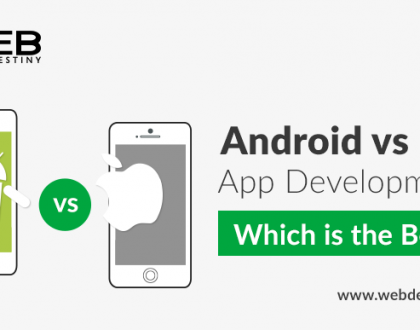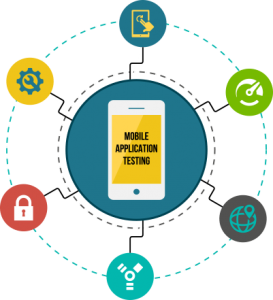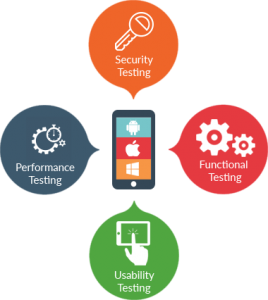Mobile App testing What you need to know in 2018

Mobile Application Testing – The basics you need to know.
Learn more about mobile application testing, its basics, and different types.
Estimations say that by the year of 2020, the number of smartphones will be 5.5 billion. We are living in an era where Smartphones are indeed getting smarter day by day. Smartphones contribute almost 50% of website views worldwide. Mobile applications also created a sensation among the marketers. In 2017, 197 billion mobile app downloads happened which will double by the year of 2021.
The marketers realized the potential of a well-designed app and hence working on the same. The mobile applications make it easy to access the business, make the transaction easier and get them higher conversion rates. Therefore, it is important to develop an app, which is easily accessible, easy to use and user interactive. When saying that developing an app is significant, mobile application testing is a major part of the process. Without finding the errors and test various factors, the app cannot be released. Apart from that, the digital world has a fierce competition. It is important to test the mobile application to make sure you stand out from the crowd.
Mobile application testing is the process of testing the functionality, usability, and consistency. Well, defined in a simple sentence, Mobile application testing can be a rigorous process. You must test, analyze, and correct every factor to provide an error free experience. We all agree on the fact that an app with bugs is a huge turn-off. In this article, I would like to share some mobile application testing and explain the need for it.
Types of mobile application testing
As already said, there are multiple factors that a tester need to analyze. Each mobile application testing considers different factors to check.
1.Cross-platform Testing:
There are multiple devices and users use multiple platforms. Users use Android, iOS, Symbian, Windows platforms and all these have different versions. An app needs to perform well in all these devices and versions simply because every user should get equal privileges and better experience.
2.Functional Testing:
This is the primary type of mobile application testing. Functionality testing checks whether the app works as per the requirements. The developer initially sets a number of requirements. If the app is for an e-commerce site, the key requirements are; the user gets access to all product, proper placements, cart design and should be able for payment. The app should meet all these requirements.
3.Performance Testing:
The testing evaluates the performance of the app. Not only the performance in favorable condition with good network and battery, but also unfavorable conditions like low battery, low network coverage etc. Some smartphones enable power saver mode when the battery percentage is below a certain level and disable some services in the mobile. There are various network services. Some use high-level networks like 4G/3G/LTE and some use low-level networks like EDGE or even GPRS.
You should carry out mobile application testing in all these conditions to evaluate the performance. Sometimes many users access the app server, how it performs then is vital. Load testing tests such conditions. If many users download, access apps at the simultaneously (like games) server should be able to load huge users, the app should be available and perform well. The performance test is done on both the application server side and user side.
4.Usability Testing:
It is an obvious fact that the user should be able to use the app easily. The app must be simple (a factor which is taken care by the developers), and easy to use. Ideally, the user shouldn’t face any difficulty when going through the app. Usability testing of Mobile application testing takes care how the apps work overall, the popups etc. If the app target multiple nations, the languages used should be precise. Readability of various fonts, images and language translation should be tested.
5.Memory, Interrupt, & Battery Testing:
The device allows some memory for the mobile application. As there are constraints for the memory usage in smartphones, it is significant to test how the app uses the memory and find out the memory leakages, if any. In addition, mobile application testing is done for the performance when the smartphone is idle, standby mode and interruption. The possible interruptions are calls, text messages, working of other application on background and notifications from the other apps. You need to check if the app crashes, freeze or any other UI glitches. A good app should be able to work despite any interruptions.
It works in the other way also. The user should be able to get the call even when the app is running. The apps would definitely consume battery power. However, it should be less than a defined amount. The lesser, the better! Higher battery consumption will lead to uninstalling the app. You may test when the battery is 10-15% and understand how long it takes to drain the battery.
6.Installation Testing:
You should make sure that the app could be downloaded from multiple stores like Google Play store, Apple store, Samsung, or MI apps. The download and installation should be easy for the user. Not only installation but also uninstalling the app. As a mobile developer, you may not wish anyone to uninstall your mobile application, but the user should get the option. The updates are another important feature. The mobile application testing should check that when updates are installed, the user database should be intact and should not affect any other performance of the phone.
7.Privacy and Security Testing:
You should make sure that there is no access to other information on the mobile other than permission granted ones. Also, make sure no other apps can access your app content.
8.Localization Testing:
There are users worldwide. As we move from places to places, the network differs. Therefore, you need to test the app in various locations to ensure that every single user gets the same, best experience. There is a global testing community of testers known as Crowd source This will help you to do mobile application testing in various locations.
Various challenges faced When the mobile applications are to test. As the rate of device and platform diversity is increasing day by day, the mobile application testing is getting difficult. As each mobile’s UI, buttons, and interface differs, we cannot use the same script for the testing, which makes it tougher. The methods of testing are not flawless. As there is a trillion device in the market, it is impossible to do testing on the real device. So normally, mobile applications are tested on emulators and some popularly used devices. That is why Alpha and beta testing is done. So that developers get feedback from the users and to correct errors.
Nevertheless, the effort is worth it. In the coming years, almost everyone will switch to Smartphones and most prefer mobile apps rather than mobile application. The significance of providing the best user experience is going to increase. That is why Mobile Application Testing is as important as the development of Mobile Application.
I believe this article helps you to understand the basics of Mobile Application Testing. Share your doubts and views in the comment section. Web Destiny Solutions is one of the top Web design company in India. and best hybrid app development company kochi With 10 years of experience, we provide high-quality service in web designing, content marketing, SEO etc. Our expert professional will help you to maintain your website, create more leads and grow your business.
Recommended Posts

Which is the Best : Android and iOS App Development
October 16, 2021

Best Practice To Increase SEO Score Through Social media in 2022
November 15, 2021

SEO Misconceptions you need to know in 2021
November 12, 2021




